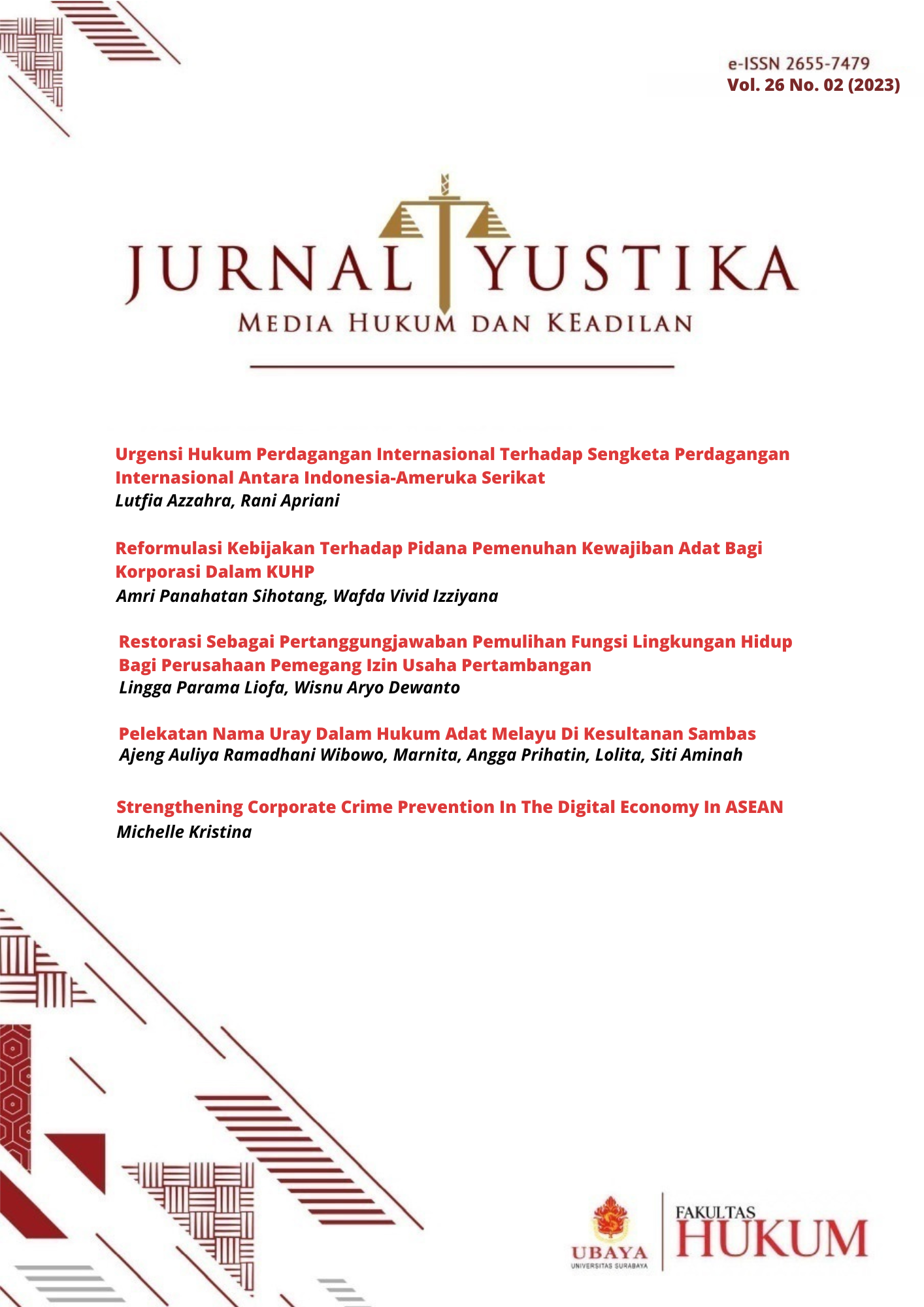Pelekatan Nama Uray Dalam Hukum Adat Melayu Di Kesultanan Sambas
 Abstract Views:
1424 times
Abstract Views:
1424 times
 PDF Downloads:
1642 times
PDF Downloads:
1642 times
Abstract
status, and a person's contribution to society and government. In the Sambas Sultanate, derived names were automatically attached to someone who was a descendant of the Sultanate's family. One of the names known in the Sambas Sultanate and the Malay indigenous community is "Uray". However, this honorary name could later be changed to "Raden" with an appointment from the Palace. This can clearly lead to changes in the social hierarchy and a person's status in society. Through a literature study related to the attachment of honorary names known in the Malay tribal community in the Sambas Sultanate. This paper aims to (i) find out how someone gets the honorary name Uray in the Malay traditional community; (ii) the causal factors that enable a person to change his honorary name from Uray to Raden; and (iii) are there any consequences that the person will receive due to the change of name. The author uses an empirical legal writing method that is descriptive exploratory in nature. The results of the writing are (i) the honorary names Uray and Raden were obtained through lineage relationships; (ii) factors that cause changes in the name of honor that a person has are marital relations and direct appointment from the Palace by the Sultan; and (iii) someone who has changed his honorary name through a traditional ceremony will have new responsibilities that make him someone who plays an important role in society. One of them is being a role model in terms of cultural preservation.
Downloads
References
A. Kadir Ahmad. 2003, Dasar-dasar Metodologi Penelitian Kualitatif, (Makasar:Indobis Media Centre), hlm.106.
Bahder Johan Nasution. 2008, Metode Penelitian Ilmu Hukum, (Bandung : Mandar Maju), hlm.124. Bambang Danu Nugroho. 2015, Hukum Adat, Bandung: Refika Aditama, hlm. 78.
Cholid Narbuko, Abu Achmadi. 2005, Metodologi Penelitian, (Jakarta : PT. Bumi Aksara), hlm.192.
Dr. Rizal Mustansyir. 2016, Kearifan Lokal Masyarakat Melayu Sambas Dalam Tinjauan Filosofis (legenda rakyat, filosofi air, dan tradisi), (Yogyakarta : Lima Media, April), hlm.18.
Haries Pribady. 2018, “QANUN & TARIKH KESULTANAN SAMBAS”, Pusat Studi Humaniora Indonesia, hlm. 36.
Joko P. Subahyo. 1991, Metode Penelitian dalam Teori dan Praktek, (Jakarta : Rineka Cipta), hlm.87- 88.
Masri Singarimbun, Sofian Efendi. 2008, Metode Penelitian Survai, (Cet. XIX; Jakarta:LP3ES), hlm.
Moh. Haitami Salim dkk. 2010, Sejarah Kerajaan Sambas Kalimantan Barat, Penelitian kerjasama Pusat Penelitian dan Pengabdian Pada Masyarakat (P3M) STAIN Pontianak dengan Puslit Lektur Keagamaan Badan Litbang dan Diklat Keagamaan Kementerian Agama Republik Indonesia.
Muhaimin, Metode Penelitian Hukum. 1969, (Mataram: Mataram University Press), hlm 83.
Neon Muhajir, Metode Penelitian Kualitatif. 2002, (Yogyakarta: Rake Sarasin), hlm.3.
Nurani Soyomukti. 2010, Pengantar Sosiologi Dasar Analisi, Teori, & Pendekatan Menuju Analisis Masalah Masalah masalah Sosial, Perubahan Sosial, & Kajian-kajian Strategis, (Jogjakarta: Ar ruzz Media), hlm.315-316.
R. Soepomo. 1952, “Kedudukan Hukum Adat di Kemudian Hari”, Pustaka Rakyat, Jakarta, hlm.30. Supardi. 2005, Metode Penelitian Ekonomi & Bisnis, (Yogyakarta: UII Press), hlm.107.
Urai Riza Fahmi. 2020, “Aturan Adat Dan Tradisi di Kesulthanan Sambas”, Pustakaone Indonesia, tanpa halaman.
Urai Riza Fahmi. 2021, “Selayang Pandang Kerajaan Islam Sambas”, Dinas Kominfo Kabupaten Sambas (Bidang E-Government), hlm. 49.
Ari Widyati Purwantiasning. 2017, Optimalisasi Fungsi Ruang Terbuka Hijau Dengan Melihat Pola Sebaran Pengunjung. Studi Kasus: Taman Tabebuya Jagakarsa, Nature (National Academic Journal Of Architecture) Vol 4, No.2. hlm.123.
Aslan dkk. 2020, “PARADIGMA BARU TRADISI “ANTAR AJUNG” PADA MASYARAKAT
PALOH, KABUPATEN SAMBAS”, Jurnal Kajian Islam dan Budaya, Vol. 18, hlm. 90.
Bambang Mudjiyanto. 2018, Tipe Penelitian Eksploratif Komunikasi Exploratory Research in Communication Study, Jurnal Studi Komunikasi Dan Media, Vol. 22 No. 1, Juni, hlm. 65–74.
Hardjito Notopuro. 1969, “Tentang Hukum Adat, Pengertian dan Pembatasan dalam Hukum Nasional”, Majalah Hukum Nasional, Nomor 4, Jakarta, hlm.49.
Jaelani. 2014, “SULTAN MUHAMMAD SYAFIUDDIN II : Pemimpin Kharismatik dari Ujung Utara Borneo Barat”, Jurnal Khatulistiwa – Journal of Islamic Studies, Volume 4 Nomor 2, hlm.127. Misyuraidah. 2017, Gelar Adat dalam Upacara Perkawinan Adat Masyarakat Komering di Sukarami
Ogan Komering Ilir Sumatera Selatan, Intizar, Volume 23, Nomor 2. hlm.24.
Muhammad Abdillah. 2021, Islam dan Budaya Politik Melayu, Jurnal Studi Islam, Vol. 17 Nomor 2, Desember.
Dinas Kebudayaan Provinsi Kepulauan Riau. 2022, “Gelar dalam Masyarakat Melayu”,(https://disbud.kepriprov.go.id/gelar-dalam-masyarakat-melayu/), April. Diakses pada 30 September 2023.

This work is licensed under a Creative Commons Attribution-ShareAlike 4.0 International License.
All articles published in YUSTIKA are licensed under a Creative Commons Attribution-ShareAlike 4.0 International (CC BY-SA) license. This means anyone is free to copy, transform, or redistribute articles for any lawful purpose in any medium, provided they give appropriate attribution to the original author(s) and YUSTIKA, link to the license, indicate if changes were made, and redistribute any derivative work under the same license.
Copyright on articles is retained by the respective author(s), without restrictions. A non-exclusive license is granted to YUSTIKA to publish the article and identify itself as its original publisher, along with the commercial right to include the article in a hardcopy issue for sale to libraries and individuals.
Although the conditions of the CC BY-SA license don't apply to authors (as the copyright holder of your article, you have no restrictions on your rights), by submitting to YUSTIKA, authors recognize the rights of readers, and must grant any third party the right to use their article to the extent provided by the license.

 DOI:
DOI:




.jpg)




